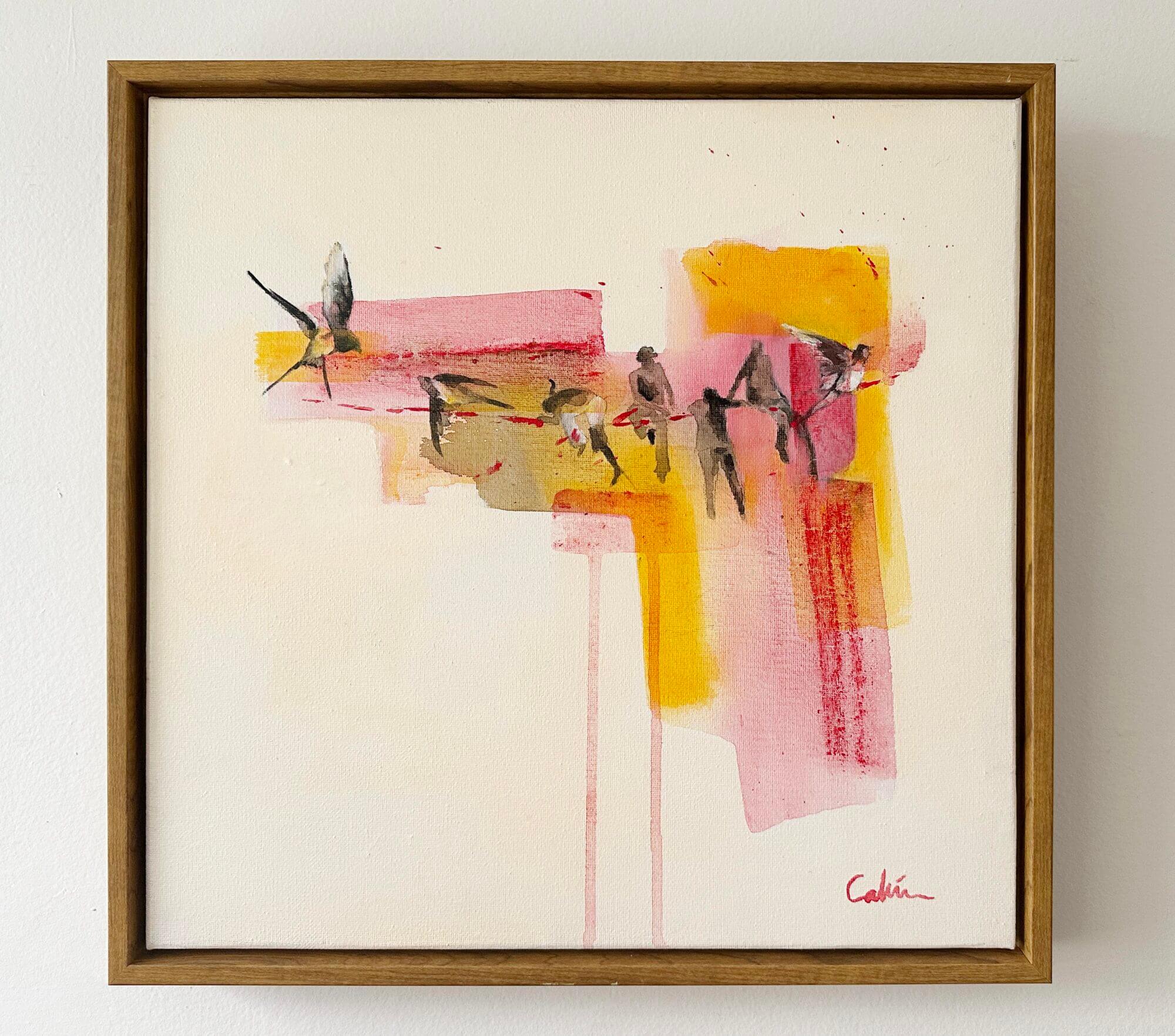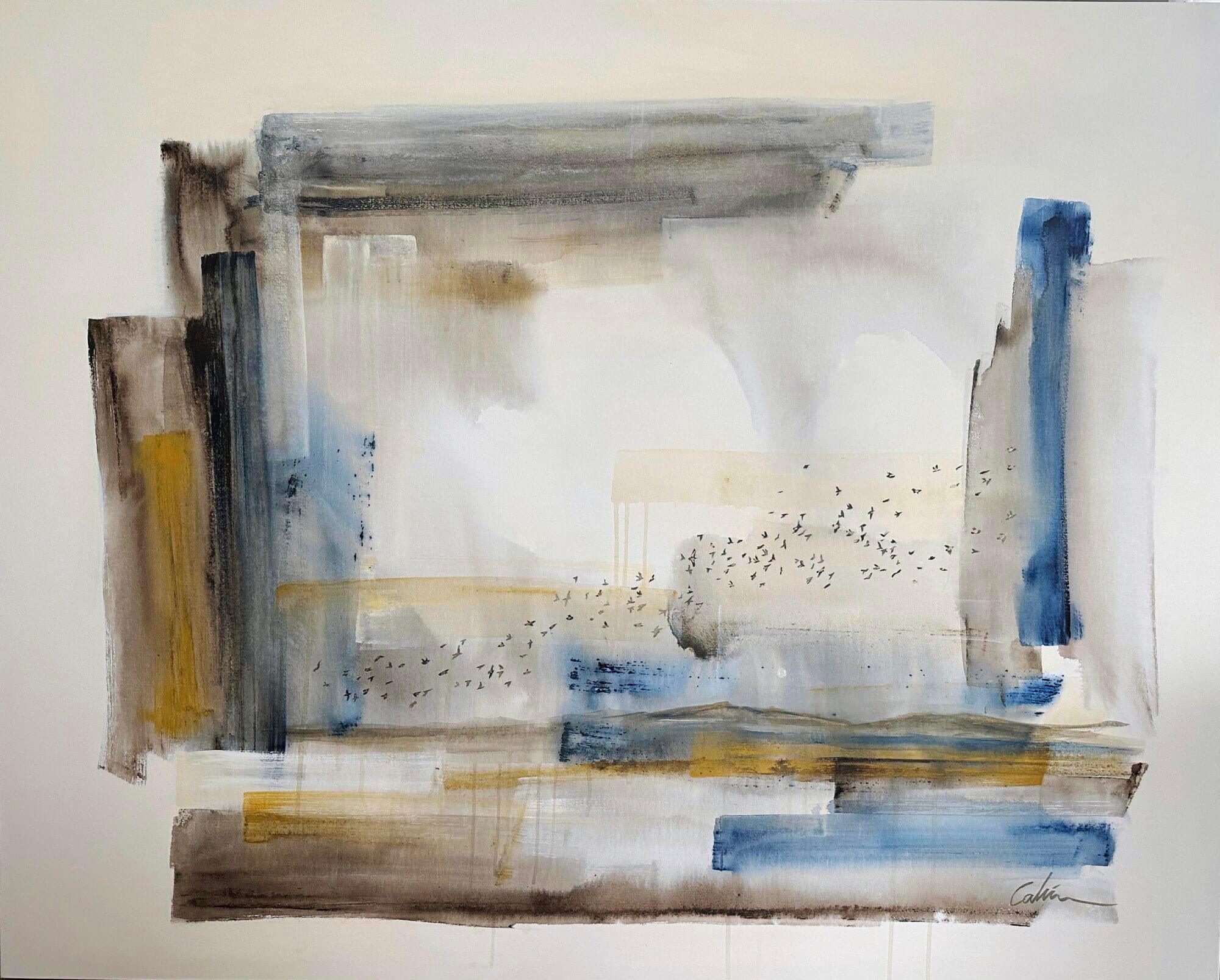


A chorus of birdsong lured artist Lucia Duque outside, where she saw an avian crowd descending on her Clinton yard one day in the fall. They filled trees and crowded on power lines, creating a compelling scene as well as a riot of sound. She took her young son, Rio, outside to watch and hear as the birds lingered on just this one stop on a long journey south toward warmer climes.
The image stayed with Duque, forming just the connection she needed for artworks underway about migrant people and their journeys. “I didn’t want to just put what you see in the newspapers. Everything is ugly with violence, war,” Duque said in her native Spanish, speaking from the heart as Deisy Carrera translated her words. “I wanted to do something … more like poetry.”
Through the 26 striking paintings of “The Nomad’s Journey,” on view at the Arts Center of Mississippi in Jackson through April, Duque channels migrants’ experiences through the stories they shared with her. She heard their reluctance to leave, memories they took, situations that drove them, dangers that plagued them and hope that sustains them on the way. Birds symbolize their flight, the lift of their hope, the ascendance of souls and the despair of violence and death. Broad strokes of color convey the emotions of migrants’ journeys, from the bright pink and yellow of hope for a better life to the dark grays and blues of sadness and loss. Her artist signature is “Calu,” a family nickname combining syllables of her first and middle names, Carmen Lucia.

Duque was 4 when her family moved from her and her father’s native Colombia to Spain, her mother’s homeland, for safety. A couple of years after she married Mississippi-born Josh Brister in Madrid, the couple moved to the United States to be closer to his family as they started their own, settling in Clinton in 2018.
Duque draws from her experiences as an artist in Spain during the migration crisis in Europe in 2015, as refugees from Syria, Afghanistan and Iraq sought asylum in Europe, overwhelming many European countries. News reports recounting the numbers — “thousands arrived” or “thousands disappeared” — hit her hard. “Behind those numbers, there were real people with stories, with lives. I felt the need to do something, even if it was small, to make their suffering visible.”
With a journalist friend in 2016, she traveled to the island of Lesbos, a main point of arrival, to see the refugee camps, talk to the people and better understand their plight. “I heard the hurt of the people,” she said, deeply affected by the experience. The war in Ukraine and ongoing migrant crisis at America’s southern border added more fuel for paintings in this show.
Duque’s aim is not political but humanitarian, by giving voice to people searching for a safe home, and creating a space for dialogue, sensitivity and connection to displaced people and their journeys.
Migrants’ journeys are not to a single, fixed destination, hence“nomad” in the show’s title. “They’re people who go from one place to another, but they’re not stable,” she said through Carrera. “We speak about refugees, but they’re not refugees until you give them political asylum.”
The people she met, moving from Syria to Greece on the island Lesbos had to remain there for a long time, in a refugee camp that struck her as more like a prison. ““It wasn’t an official prison, but they couldn’t leave. From that first site, they would go to another site … and then they would be sent to another country or another region, to be aided by some organization that would help them relocate.”
Similarly, “People from Honduras or El Salvador or Guatemala that come to the border — they’re coming here and they’re waiting. They’re not established there. It’s just a momentary spot.”
Abstract paintings with some figurative elements combine European sophistication and the color she inherited from her Latin American roots, Duque said.“When the Winds Call” merges two memories in its hint of a horizontal line, figures in motion and birds on the wing. It recalls the wire birds perched on, and news reports she saw growing up, of people trying to jump the border fence in Ceuta and Melilla, Spanish cities bordering Morocco on the North African coast. “I wanted to portray the people jumping, with the hope of something new and the wings to fly,” Carrera translated for Duque.
Artworks depict migrants’ means of travel, by ship, inflatable rafts and La Bestia (“The Beast”), the freight train Central American migrants climb onto in a perilous attempt to make it through Mexico to the U.S. border.

In a painting of the Ukrainian capital of Kyiv before the war, flying cranes may be harbingers of civilians’ flight following the Russian invasion. In another, painted after the bombing of a children’s hospital in Kyiv, vultures circle and perch in barren trees amid broad swipes of stormy gray, angry red and yellow, darkened in the layers.
An image of a refugee camp speaks of being stuck in time, waiting to move on. She recalled the chaotic scene in Lesbos at the refugee camp and the tears she shed. People told her they had not wanted to leave their home, even in wartime, but wanted to hang on and hope it would end. “A father with four or five children told me, ‘The moment that I decided to go was when a bomb fell on my kids’ school.” With that, he knew, “There is no more hope here.”
Through her friend’s contact, they visited a little-known cemetery on Lesbos — donated land for burials because there simply was no where else. “When you got there, you would see just a type of rock on top of the grave and it would say ‘2-year-old child’ or ‘woman died in (the year).’ This always makes me cry,” she said, thinking of the many who died on their journey, the lack of identifying information, the families who would not know. “These were a type of mass graves. The people that were burying them tried to give them some type of dignity with whatever details they could, but they didn’t know anything.”

“Between Two Shores” is her artistic response — a large canvas of blue and golden hues and a flock of birds in the sky. A touch of gold graces their wings, representing ascending souls with a message of“We haven’t forgotten you, you were here.’”
“We see images of refugees in the news, and we think, ‘Oh, my gosh, they’re so different. They’re desperate.’ But really, they’re just like us,” Duque said. “And if something ever happens in the United States, we would be next to go and try to find refuge somewhere else.
“i want people to be conscious of the fact that this is a situation that is growing,” she said, citing a news report that projected 16 million people would be in a situation of displacement in 2025. “It’s growing, it’s not stopping, it’s not getting better and we need to keep talking about it.
“This exhibit is really to honor the people that are suffering, and to do it with dignity and give them all of the respect that they deserve. And also with the hopes that it would wake up in our hearts the response of ‘OK, this is happening. How can I help?’”
Lucia Duque’s “The Nomad’s Journey” is on view at the Arts Center of Mississippi in Jackson through the month of April. Join Duque for an Artist Talk, 2-3:30 p.m. April 26 at the Arts Center. For viewing at other times, call 601-960-1500 to enter the building.
The post Art exhibit explores the hope and the humanity in migrants’ journeys appeared first on Mississippi Today.
- IHL taps members for Jackson State president search advisory group - November 24, 2025
- DNA evidence tied to rape, killing of 6-year-old Greenville girl is missing, attorneys allege in court filing - November 24, 2025
- Egg Bowl week begins as Kiffin’s run at Ole Miss appears to be at end - November 24, 2025